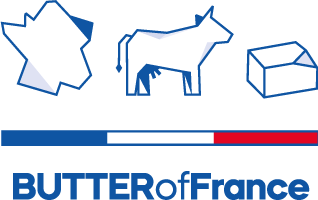Butter
Essential butter
Butter is a national treasure, the reflection of a terroir, of an expertise. For some, butter can bring back a flood of memories and arouse emotion… emotions brought about by the memory of a slice of bread and butter eaten during childhood, or a slice of pound cake, the characteristic flavours of which leave their mark on us for a long time. It could even be called the Swiss army knife of gastronomy, as its uses seem infinite.
Walk into a kitchen and look for the butter… it is never far away. Trends change, culinary techniques evolve, but it remains the favourite ingredient of chefs. Used for roasting, browning meat or fish, glazing vegetables, adding body to a sauce, and even as the main ingredient in white sauce or hollandaise, butter has a thousand virtues. Adorned in a golden colour and blessed with a delicate scent, a knob of butter glides into pancake batter or purée. When clarified – in other words, free of whey – it can be used to slow-cook fish, such as salmon or St. Pierre, without compromising the delicate flesh. When immersed in clarified butter, the fish is protected from the harsh flames, feeling only the caress of the butter brought to about sixty degrees.
The strenght of butter
Authentic butter, a source of pleasure
Butter is an entirely natural product in its pure state. To make 1 kg, you need 22 L of milk. It has survived for thousands of years. It has been made the same way for thousands of years and is still the same smooth, soft and delicious product it has always been. Even through the ages, it has remained a natural and traditional product, an emblem of European agriculture and gastronomic cultures. Anchored in regional products and ancestral expertise, it is the benchmark product of pleasure and gastronomy.
A thousand year old manufacturing process
Butter production methods have remained unchanged for 5000 years... or nearly! A butter mould found in a peat bog in Ireland testifies to the use of recognisable equipment nearly 3,000 years before us. A Sumerian tablet dating back to 2500 BCE recounts the milking of cows and churning the milk by rolling it in a large jar. The churning system has been perfected over the centuries and health precautions have improved, especially with pasteurisation, but the process has remained essentially the same.
 繁體中文
繁體中文  简体中文
简体中文  한국어
한국어  Français
Français 
